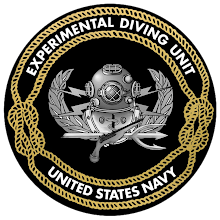Born September 26, 1917 in Wewahitchka, Granny was a long-time Panama City, Fla. resident of the St Andrews neighborhood. Her memory lives in the countless hearts of family, friends and all of those with whom she shared her life. She is remembered for living a remarkable life filled with sacrifice, compassion, and caring. All of those who knew her were blessed with the gift of her unconditional love.
"Granny' was the widow of Master Diver Squire who was assigned to NEDU and helped in the salvage of the USS Squalus. In September 2007 she donated Squalus newspapers and artifacts to the NEDU library, which are prominently displayed.

Details on MDV Squire and his part in the Squalus rescue are below:
". . .The rescue effort had taken numerous trips
because of the limited space in the diving bell, a steel capsule pressurized
with regulated air, used to transport the men from the sub to the surface.
Other than the numerous but expected problems with heliox, a not fully
tested, deep diving technique using a mixture of oxygen and helium, the
rescue seemed to be coming right along until the last rescue trip was to be
made. A down-haul cable raising the bell from the stricken sub to the USS Falcon, a
submarine rescue and salvage ship, fouled on the winch which prevented the bell from being raised any further from the bottom. The cable was cut, plunging the bell back down to the bottom, but this time to the thick mud, once
again trapping the last nine remaining survivors along with two bell
operators. Because the cable was cut at the surface with over 100 feet of
cable still attached to the rescue bell it was deemed too risky to try and
raise it as is. Someone would have to dive down in the dark, coldwater to
find the bell and cut it free so that a new cable could be attached. Squire
got suited up. After just a few minutes he called back to the surface, asking
for a pair of shears or cable cutters. Relying only on his own strength,he
cut the down-haul cable and freed the bell for recovery. Many photos and
memorabilia were donated to NEDUAugust 23, but the most significant item was
the section ofthe down-haul cable that was cut away, saving the lives of nine
men."
because of the limited space in the diving bell, a steel capsule pressurized
with regulated air, used to transport the men from the sub to the surface.
Other than the numerous but expected problems with heliox, a not fully
tested, deep diving technique using a mixture of oxygen and helium, the

rescue seemed to be coming right along until the last rescue trip was to be
made. A down-haul cable raising the bell from the stricken sub to the USS Falcon, a
submarine rescue and salvage ship, fouled on the winch which prevented the bell from being raised any further from the bottom. The cable was cut, plunging the bell back down to the bottom, but this time to the thick mud, once
again trapping the last nine remaining survivors along with two bell
operators. Because the cable was cut at the surface with over 100 feet of
cable still attached to the rescue bell it was deemed too risky to try and
raise it as is. Someone would have to dive down in the dark, coldwater to
find the bell and cut it free so that a new cable could be attached. Squire
got suited up. After just a few minutes he called back to the surface, asking
for a pair of shears or cable cutters. Relying only on his own strength,he
cut the down-haul cable and freed the bell for recovery. Many photos and
memorabilia were donated to NEDUAugust 23, but the most significant item was
the section ofthe down-haul cable that was cut away, saving the lives of nine

men."


No comments:
Post a Comment